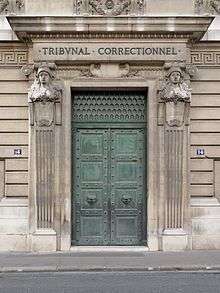Tribunal de grande instance de Paris
 |
| This article is part of a series on the politics and government of France |
|
|
Related topics |
| France portal |
The Tribunal de grande instance de Paris (abbreviated TGI; in English: High Court of Paris), located at the Palais de Justice in Paris, in l’Île de la Cité (city center), is the largest court in France by the number of cases.
Jurisdiction
The jurisdiction of the High Court of Paris is nationwide for matters of:
- crimes against humanity and war crimes,[1]
- crimes committed outside the territory by members of the French armed forces or against them in peacetime[2] (since the removal of the Tribunal of the armies of Paris in 2012),
- corruption and tax evasion.[3] The financial prosecutor of the Republic is located near the court.
- terrorism.[4]
The court has inter-regional jurisdiction in matters of:
- complex economic and financial affairs[5][6] (one of eight specialized interregional courts of France)
- Health Affairs[5][7] (one of the two specialized courts with that attached to TGI de Marseille).
For all other matters, its jurisdiction is limited to the entire capital. It is one of the appeals courts for the Court of Appeal of Paris.
Organization
As of 2009, TGI is organized in the following hierarchy:[8]
- President and three Vice-Presidents
- Civil Service: 12 civil divisions and specialized services
- Penal Service: 15 Correctional facilities and specialized services
- Prosecutor and two deputy prosecutors
- 1st division: public action, sectored,[TNote 1] real-time processing: 4 sections,
- 2nd division: financial center: 2 sections,
- 3rd division: general administration, civil and news: 4 sections,
- 4th division: fight against terrorism, offenses against state security, organized crime: sections 2,
- 5th division: public health center, fight against economic and social delinquency: 2 sections.
Location
The TGI is located in the Palace of Justice on the Île de la Cité along with the Court of Appeal of Paris and the Court of Cassation. This site (formerly called Palace of the City) hosted the Parlement during the Ancien Régime. The Sainte-Chapelle and Conciergerie are remnants of the medieval royal palace, the Palais de la Cité, open to the public today. The palace is adjacent to 36, quai des Orfèvres where the Direction Régionale de Police Judiciaire de Paris (Regional Directorate of the Judicial Police of Paris) is located.
The TGI will be located at the Judicial Campus of Paris (Cité judiciaire de Paris) in the Batignolles district. The announcement was made on 29 April 2009 by Nicolas Sarkozy, and the contract signed in 2012. The Regional Directorate of the Judicial Police of Paris will be collocated at this site[9][10]
 Entrance to Court of Corrections at 14 quai des Orfèvres (photo taken en 2006).
Entrance to Court of Corrections at 14 quai des Orfèvres (photo taken en 2006).- Salle des Pas-perdus (photo taken in 2012).
- Financial and economic center and Public jealth center at 5-7 rue des Italiens, Paris, since 1999 (photo taken in 2015).
See also
References
- ↑ "Code de procédure pénale - Article 628" [Criminal Procedure Code - Article 628]. Legifrance.gouv.fr (in French). Le Service Public de la Defussion de Droit. 15 December 2011. Retrieved 27 January 2016.
- ↑ "Code de procédure pénale - Article 697-4" [Criminal Procedure Code - Article 697-4]. Legifrance.gouv.fr (in French). Le Service Public de la Defussion de Droit. 1 January 2012. Retrieved 27 January 2016.
- ↑ "Code de procédure pénale - Article 705" [Criminal Procedure Code - Article 705]. Legifrance.gouv.fr (in French). Le Service Public de la Defussion de Droit. 1 February 2014. Retrieved 27 January 2016.
- ↑ "Code de procédure pénale - Article 706-17" [Criminal Procedure Code - Article 706-17]. Legifrance.gouv.fr (in French). Le Service Public de la Defussion de Droit. 1 January 2015. Retrieved 27 January 2016.
- 1 2 "Code de procédure pénale - Article 704" [Criminal Procedure Code - Article 704]. Legifrance.gouv.fr (in French). Le Service Public de la Defussion de Droit. 1 January 2015. Retrieved 27 January 2016.
- ↑ "Code de procédure pénale - Article D47-3" [Criminal Procedure Code - Article D47-3]. Legifrance.gouv.fr (in French). Le Service Public de la Defussion de Droit. 1 February 2015. Retrieved 27 January 2016.
- ↑ "Code de procédure pénale - Article D47-5" [Criminal Procedure Code - Article D47-5]. Legifrance.gouv.fr (in French). Le Service Public de la Defussion de Droit. 1 January 2012. Retrieved 27 January 2016.
- ↑ Chancellery cited by du Luart, 2009, page 12
- ↑ Leclerc, Jean-Marc (11 June 2009). "Une tour de 150 m pour le futur Palais de justice de Paris" [A 150 m Tower for the Future Paris Courthouse]. Le Figaro (in French). Paris. Retrieved 15 February 2015.
- ↑ Johannès, Franck (15 January 2015). "Nouveau palais de justice de Paris : le contrat sera renégocié" [New courthouse in Paris: the contract will be renegotiated]. Le Monde (in French). Paris. Retrieved 15 February 2015.
Bibliography
- M. Roland du Luart (14 October 2009). "La future implantation du tribunal de grande instance (TGI) de Paris : la fin des hésitations" [Future implementation of the High Court of Paris : The end of delay]. senat.fr (in French). Senate of France. Retrieved 27 January 2016.
Translator's Notes
- ↑ Translator is unsure of the translation of this word
Coordinates: 48°51′19″N 2°20′45″E / 48.8553°N 2.3458°E